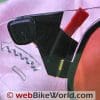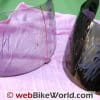Regular webBikeWorld visitors know that Akuma Helmets, in partnership with Mr. Wizard himself, Kerry Harris, have developed some of the coolest and most interesting helmets and helmet technologies going.
For example, they developed the Sunshift photochromic visor (review) a couple of years ago, which we reported on during our review of the Akuma Ghost Rider helmet (review).
Akuma also pioneered the “IPS” Integrated Power System for motorcycle helmets, which was (and is, as far as I know) the first on-board integrated rechargeable power system for motorcycle helmets.
IPS powers everything from the built-in, forward-facing LED flashlight on Akuma helmets and thepolice Shoei flip-up (review) to the rear-facing red LED “exhaust” lights that fire up on the back of the Akuma Ghost Rider and Akuma Stealth (review) motorcycle helmets.
IPS also powers the ventilation fan in the AFX FX-11 Lightforce helmet (review).
The potential for an on-board, integrated motorcycle helmet power pack is unlimited.
We showed you one example at least year’s Dealer Expo, when we described the ground-breaking Akuma electrochromic visor in a special report posted live from the show, along with a video, which I’ve also included below.
That visor was powered by the on-board IPS system in an Akuma helmet, and as you can see in the video, when the visor is switched on, the tint fades from light to dark — a built-in, electrically powered, on-demand motorcycle helmet visor tint!
Well, Akuma has been hard at work ever since, and we recently had an exclusive opportunity to sample the latest evolution of the world’s first on-demand visor tint technology for motorcycle helmets, now called “Tint on Demand”, or TOD.
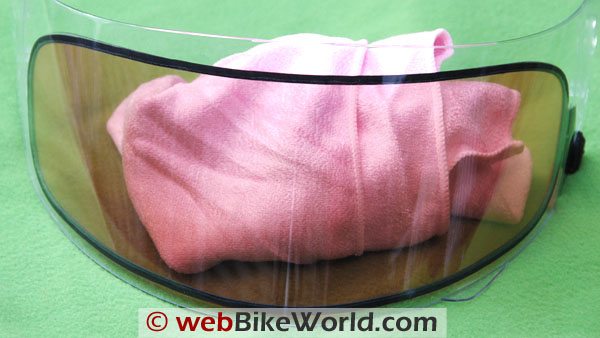
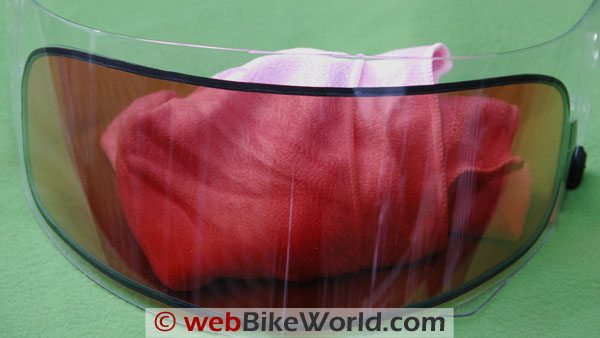
The Akuma Gemini “Tint on Demand” Motorcycle Helmet Visor
The photos and video on this page show the near-final prototype of the Akuma “Gemini” TOD motorcycle helmet visor.
So what’s the difference between the original electrochromic visor from the 2008 Dealer Expo and the technology used in the Gemini? Lots!
The Gemini is a completely new concept. It uses the “E-Tint” electro-LCD system, developed byAlphaMicron in partnership with the U.S. Air Force for fighter pilot helmet visors!
Where the electrochromic visor took about 30 seconds or so to change the visor tint from light to completely dark, the Gemini “Tint on Demand” technology is nearly instantaneous — it takes about 0.1 second to turn the tint on or off, as you can see in the video included below.
The Gemini visor consists of a thin insert that is applied to the back of a standard Akuma visor. The insert is similar to the Fog City or ProGrip visors (review) familiar to motorcyclists. The Gemini visor insert also provides a similar anti-fog capability.
The TOD system in the Gemini visor is controlled by a tiny and flat circuit board attached to the inside of the visor, down on the lower left. The system is powered by a tiny battery on the circuit board — the battery is so small I couldn’t even identify it.
The Gemini only requires a very small amount of power to operate, and Akuma says it should last for 30 hours in the “on” dark tint state before needing a recharge.
The visor shown here fits the Akuma R2- and R3-series helmets; unfortunately we didn’t have either one of those models available, or I would have taken the visor out for a spin.
But it’s obvious that this technology will revolutionize motorcycling, and I can’t wait to try the final version.
Akuma plans on releasing the Gemini at the 2009 Powersports Dealer Expo, and you can be sure we’ll be there for our 5th year of live reporting.
A Note on the Photos and Video
It’s important to keep in mind that the visor shown here is a prototype, so the depth, tint color and other factors may change slightly between this version and the final production visor.
Also, note that the visor shown here is not mounted on a helmet, so the sunlight outdoors is spread both in front and in back of the visor, making the tint seem darker with the visor switched off and lighter with the visor switched on.
The effect is different than when the visor is mounted on a helmet, because the helmet is much darker inside and behind the visor.
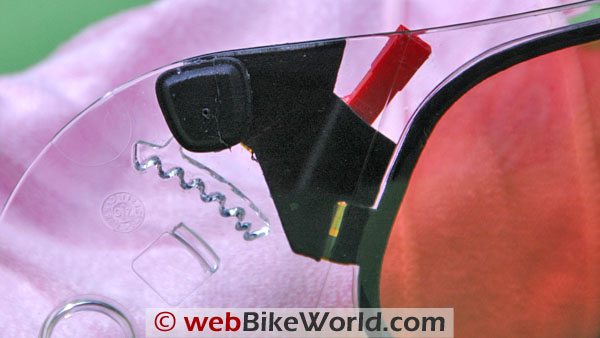
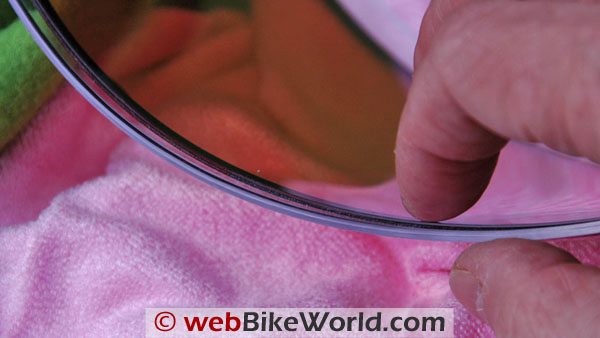
Each visor will come with a recharger, although the normal IPS recharger provided with Akuma helmets will also work.
The separate recharger is the way to go for this application, because it will allow the visor to be moved from helmet to helmet and the separate recharging capability will be necessary when the Gemini visors become available for other brands of helmets that might not have the IPS integrated power system.
Akuma says the on-board battery will recharge in 15 minutes. The recharger connects to the red lead that can be seen in the photo. The lead is nearly as big as the entire controller and battery combined!
The Gemini Tint on Demand visor will be available in different color tints and strengths; the amber version is shown here. The idea is to reduce glare for motorcycle riders — not to make a nearly opaque visor.
For that, see my brief report on the new Akuma “Aegis” hydrophobic visor below (those Akuma guys — do they ever stop?).
Kerry had a few more interesting comments on the Gemini visor.
He said “We redesigned and upgraded the technology (from the electrochromic visor). The Gemini uses a much better and more reliable technology and it never wears out.
“As long as you have battery life, you can tint the visor on and off. The major safety advantage to our liquid crystal technology is that if the battery goes dead, the visor will default to clear.”
And here’s something else he said that sounds very intriguing:
“The technology is also many times upgradable, meaning I will design variations that will be useful in many specific areas for motorcycle riding and other power sports. The electronics and battery will also be easily replaceable so, in the event that you damage your electronics or battery, you can simply replace the housing and not have to purchase an entirely new visor.”
The prototype Gemini visor shown here weighs 140 g (5.0 oz.), while the standard clear visor shown in the photos and videos weighs 118 g (4.125 oz.) and the Aegis visor described next weighs 110 g (3.875 oz.).
The first Gemini visors will, naturally, fit only the Akuma helmets, but Akuma plans on releasing Gemini visors for other brands of helmets soon after. Current plans are to price the Gemini visor at around $179.00.
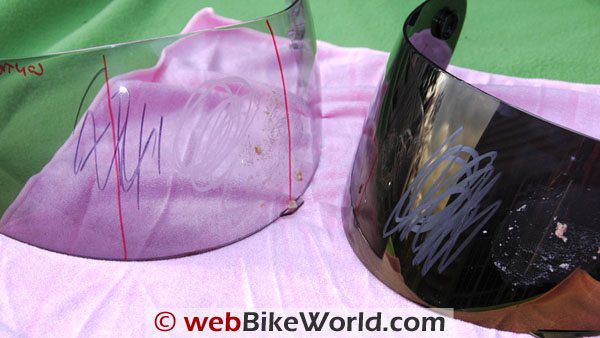
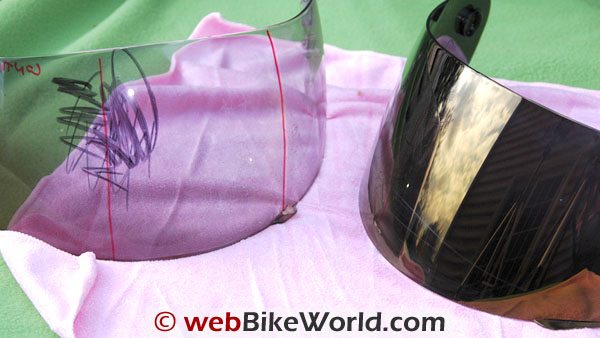
The Akuma Aegis Hydrophobic Visor
In their spar time, the Akuma folks have also developed the Gold “Aegis” visor. This one is hydrophobic — which basically means that it has a built-in affinity to repel water and other liquids.
The hydrophobic properties of the Aegis visor also help make it much easier to clean. And, while they’re at it, they threw in an anti-fog and anti-scratch treatment at well.
As many owners have discovered, mirror plated or iridium plated visors must be handled very carefully, as the plating can be easily scratched and it usually eventually peels off the visor surface.
Akuma says that won’t happen on the Aegis visor, and we’ve put this one through some pretty rough trials that we would never do to a normal plated visor and it’s held up perfectly.
We added some extra footage at the end of the Gemini video below to illustrate the capabilities of the new Aegis visor. Kerry told us to go ahead and beat it up, so we took a standard clear visor from another helmet and set up a quick comparison.
We applied some old cooking grease to each visor (the only type of grease handy at the time!), then scribbled on the front of the visors with wax from a candle and also a permanent marker.
As you can see in the video, the permanent marker sticks immediately to the standard clear visor, but the ink just doesn’t stick at all to the hydrophobic Aegis visor.
We then took a dry microfiber towel and tried wiping the ink and crud off both visors.
Note that this is not recommended; Akuma recommends using water to clean the Aegis visor or using water a a few drops of mild dishwashing soap if necessary to clean it. Normally, you’d never want to dry wipe a motorcycle helmet visor because it would likely cause scratches.
But as you can see in the video, the crud remains on the clear visor but it’s easily removed on the Aegis visor. I’ve included a couple of before/after static photos also above. And yes, the water does bead right up and rolls right off the Aegis visor also!
The Aegis visor is currently available for the Akuma R2 Specter and R3 Apache helmets at a super price of only $55.00. It can be ordered online from our affiliate RevZilla.
Publication Date: November 2008
Owner Comments and Feedback
See details on submitting comments.




